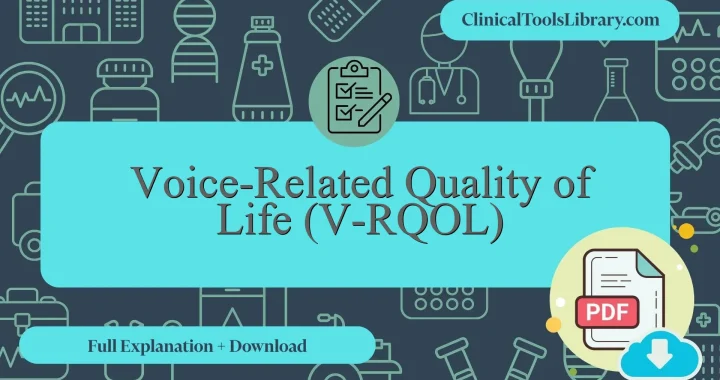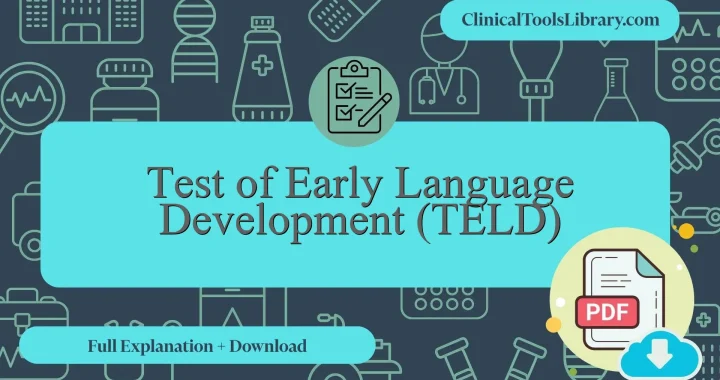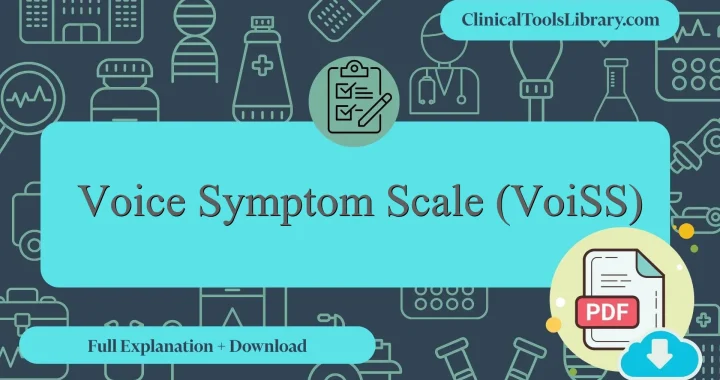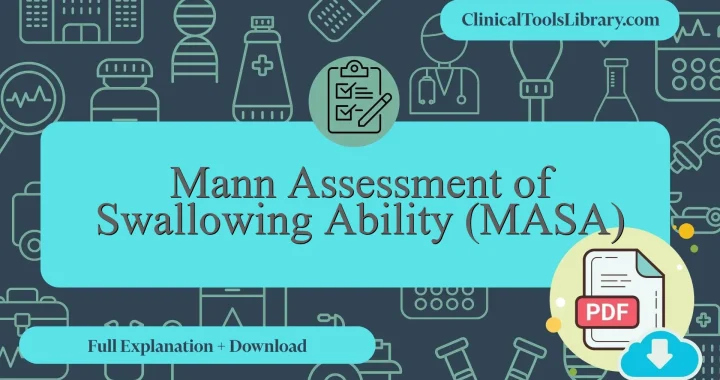In this article, we explain everything you need to know about the Voice-Related Quality of Life (V-RQOL). We will cover the aspects it evaluates, the target population, a detailed step-by-step explanation, and how to interpret its results. Additionally, we will dive into the scientific evidence supporting this tool (diagnostic sensitivity and specificity) in clinical assessment. You will also find official and unofficial sources available for download in PDF format.
What does the Voice-Related Quality of Life (V-RQOL) assess?
The Voice-Related Quality of Life (V-RQOL) is a validated instrument designed to assess the impact of voice disorders on a patient’s daily functioning and emotional well-being. It specifically measures the individual’s perceived handicap resulting from dysphonia and other voice impairments by evaluating physical, social-emotional, and functional domains. The primary purpose of the tool is to provide clinicians with a standardized method for quantifying the subjective effects of voice conditions, aiding in voice-related quality of life scoring and treatment outcome monitoring. The voice-related quality of life questionnaire offers a complementary perspective to other tools such as the Voice Handicap Index, facilitating a comprehensive evaluation of voice disorders. Proper VRQOL interpretation requires familiarity with scoring protocols detailed in the voice-related quality of life pdf manuals, ensuring accurate clinical application and research utilization.
For which type of patients or populations is the Voice-Related Quality of Life (V-RQOL) intended?
The Voice-Related Quality of Life (V-RQOL) questionnaire is indicated primarily for patients experiencing dysphonia or other voice disorders affecting functional communication. It is most useful in clinical contexts involving otolaryngology and speech-language pathology, where objective assessment of the patient’s perceived vocal handicap is essential. This tool facilitates VRQOL interpretation by quantifying the psychosocial impact of voice impairment in populations such as individuals with benign vocal fold lesions, laryngeal paralysis, or post-treatment evaluation following laryngeal surgery. The V-RQOL complements other instruments like the Voice Handicap Index by offering targeted insight into quality of life domains specifically influenced by voice function, making it valuable for both baseline assessment and monitoring treatment outcomes through standardized voice-related quality of life scoring.
Step-by-Step Explanation of the Voice-Related Quality of Life (V-RQOL)
The Voice-Related Quality of Life (V-RQOL) assessment consists of 10 items designed to evaluate the patient’s perception of their voice impairment. The questionnaire includes questions related to physical functioning and social-emotional aspects, with items such as “My voice makes it difficult to talk to people” and “People have difficulty understanding my voice.” Responses are recorded using a 5-point Likert scale ranging from 1 (not a problem) to 5 (a severe problem). To administer the V-RQOL, the clinician instructs the patient to consider their typical voice use over the past week and select the response that best reflects their experience. The total score is calculated by summing the item responses and transforming the raw score to a 0–100 scale, where higher scores indicate better perceived voice-related quality of life. This tool is validated for various voice disorders and provides a reliable measure of voice handicap severity in clinical and research settings.
Voice-Related Quality of Life (V-RQOL) Questionnaire PDF – Original & English Versions Download
Below are downloadable resources including the original and English versions of the Voice-Related Quality of Life (V-RQOL) questionnaire available in PDF format. These materials support clinical assessment and research by facilitating standardized voice-related quality of life scoring and VRQOL interpretation, aiding healthcare professionals in evaluating the impact of voice disorders with precision and consistency.
How to interpret the results of the Voice-Related Quality of Life (V-RQOL)?
The Voice-Related Quality of Life (V-RQOL) test quantitatively assesses the patient’s perceived impact of voice disorders on daily activities, with scores ranging from 0 to 100, where higher values indicate better voice-related quality of life. Interpretation involves comparing individual scores to established reference ranges: typically, scores above 90 suggest minimal impairment, 70–90 indicates moderate voice-related difficulties, and below 70 reflects significant functional limitation due to voice disorders. Healthcare professionals calculate the total V-RQOL score by averaging responses across physical and socio-emotional domains using the formula V-RQOL Score = (Sum of item scores / Number of items) × 100. For instance, a score of 65 denotes considerable impact, guiding clinicians to investigate underlying causes such as laryngitis or vocal fold nodules and tailor interventions accordingly. Practically, these results assist in monitoring treatment efficacy and making informed decisions about therapeutic adjustments to improve patient outcomes.
What scientific evidence supports the Voice-Related Quality of Life (V-RQOL) ?
The Voice-Related Quality of Life (V-RQOL) test was developed in the late 1990s as a patient-reported outcome measure specifically designed to evaluate the impact of voice disorders on daily functioning and well-being. Validated initially by Hogikyan and Sethuraman in 1999, the instrument demonstrated strong psychometric properties, including high internal consistency and test-retest reliability. Subsequent studies have confirmed its sensitivity in assessing conditions such as benign vocal fold lesions, laryngeal cancer, and vocal fold paralysis, correlating well with objective acoustic measures and laryngeal imaging findings. The V-RQOL has been extensively referenced in peer-reviewed research, reinforcing its clinical utility and scientific rigor across diverse populations and languages, which supports its role as a standard tool in both clinical and research settings for evaluating voice-related quality of life impairments.
Diagnostic Accuracy: Sensitivity and Specificity of the Voice-Related Quality of Life (V-RQOL)
The Voice-Related Quality of Life (V-RQOL) instrument demonstrates variable sensitivity and specificity depending on the population and clinical context. Studies report sensitivity values ranging from approximately 70% to 85%, indicating a relatively high ability to detect voice disorders such as benign vocal fold lesions and laryngeal paralysis. Specificity tends to be slightly lower, often between 65% and 80%, reflecting some limitations in distinguishing unaffected individuals from those with subtle voice impairments. These metrics underscore V-RQOL’s utility as a patient-reported outcome measure that complements objective laryngeal assessments rather than serving as a standalone diagnostic tool.
Related Scales or Questionnaires
The Voice Handicap Index (VHI) is a widely used instrument similar to the Voice-Related Quality of Life (V-RQOL) questionnaire, offering comprehensive assessment of the psychosocial impact of voice disorders. Unlike the V-RQOL, which focuses on functional and social-emotional domains related to voice, the VHI provides a more detailed subscale structure but may require longer administration time. Another comparable tool is the Voice Symptom Scale (VoiSS), notable for its sensitivity to laryngeal pathologies, though its complexity might limit routine clinical use. Both of these instruments, including the V-RQOL and related scoring and interpretation guidelines such as the voice-related quality of life pdf and voice-related quality of life scoring, are thoroughly explained and available for download on ClinicalToolsLibrary.com. While the V-RQOL offers simplicity and ease of use, its narrower domain coverage can be seen as a disadvantage relative to the broader scope provided by VHI and VoiSS, which address multiple dimensions of voice impairment. It is important to note that despite differences, all these scales provide valuable patient-centered data for conditions affecting vocal function.




